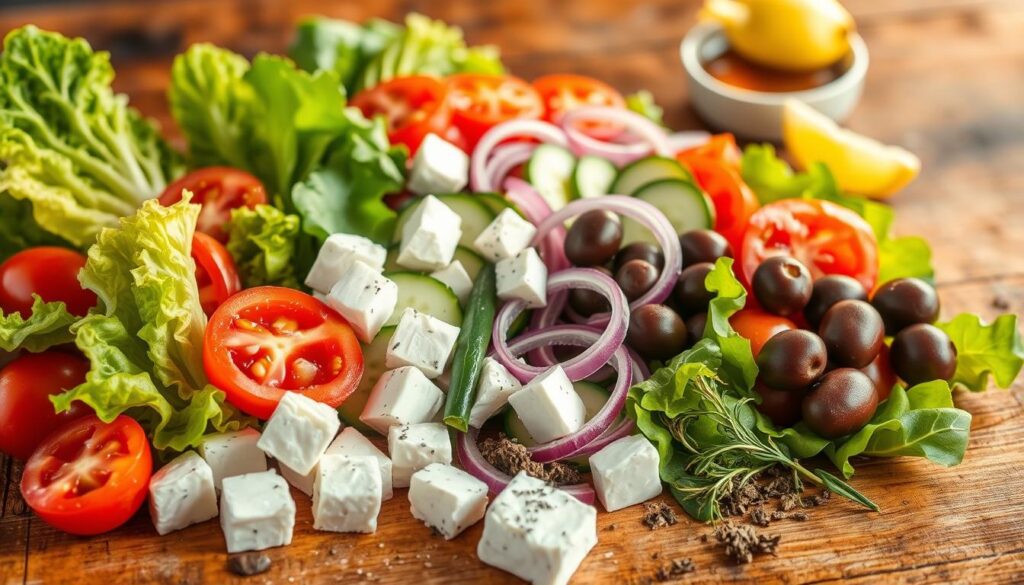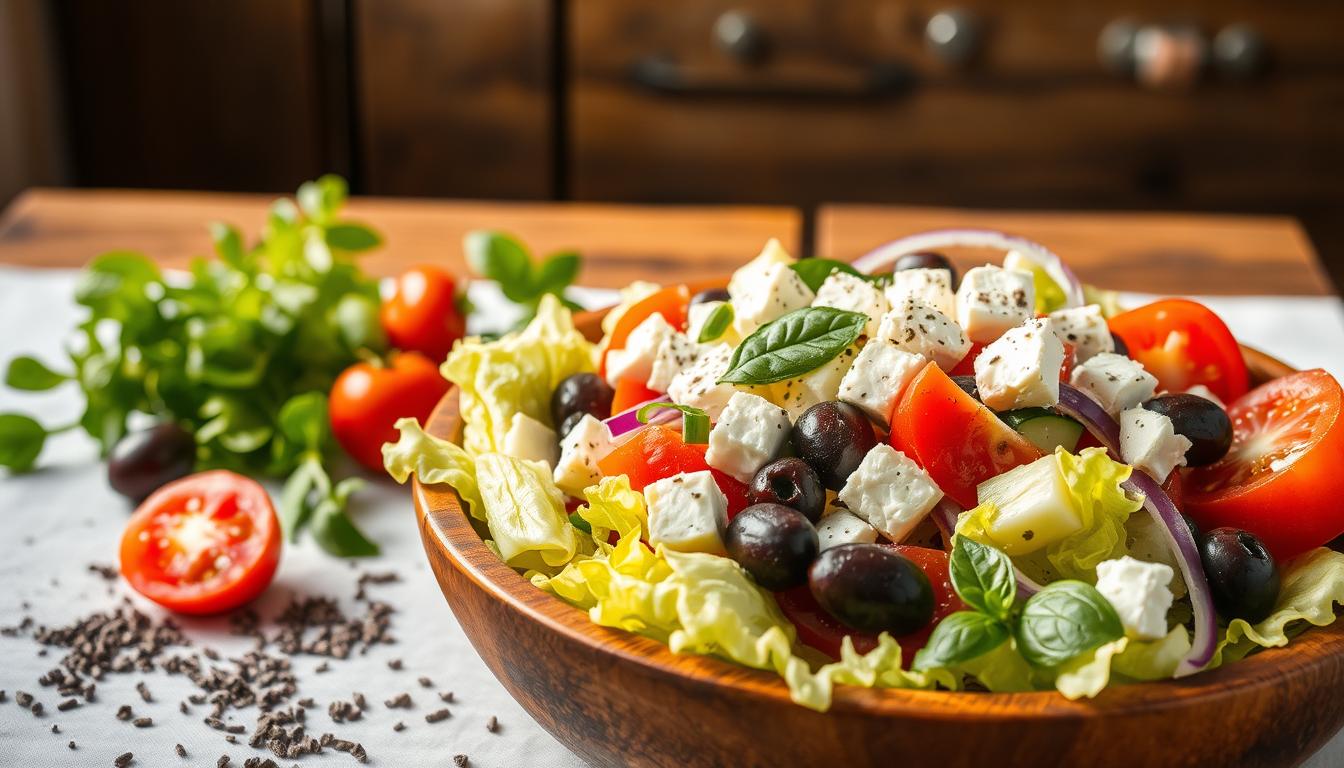Every summer, my grandmother’s kitchen became a Mediterranean paradise. Her Greek salad recipe was a family tradition. It’s more than a dish; it’s a celebration of simplicity, flavor, and heritage that connects us to Greece.
Making an authentic Mediterranean salad is more than just tossing veggies. It’s about finding the right balance of fresh ingredients and preparing them with care. This recipe will show you how to make a simple yet delicious Greek salad.
If you’re a home cook looking to improve or someone who loves Mediterranean food, this guide is for you. It will teach you to make a Greek salad that feels like a trip to the Greek islands.
Key Takeaways
- Learn the essential ingredients for an authentic Greek salad
- Discover techniques for selecting the freshest produce
- Understand the importance of proper ingredient preparation
- Master the art of creating a perfect Mediterranean salad
- Explore tips for elevating your Greek salad presentation
Understanding the Basics of Greek Salad
Making an authentic Greek salad is more than just mixing ingredients. It’s about choosing the right parts that make it a true Mediterranean dish.

To make the perfect Greek salad, start by knowing its key ingredients. Traditional recipes use fresh, top-quality produce. This brings alive the salad’s flavors and textures.
Essential Ingredients for an Authentic Greek Salad
- Ripe, juicy tomatoes (heirloom or roma varieties)
- English or Persian cucumbers
- Green bell peppers
- Sweet red onions
- Kalamata olives
- Authentic Greek feta cheese
The Importance of Ingredient Freshness
Freshness is key to a great Greek salad. Choose vegetables in their peak season for the best taste and health benefits. Your ingredients should be crisp, colorful, and bursting with natural taste.
“In Greek cuisine, the quality of ingredients speaks louder than complex preparations.”
Regional Variations to Explore
While the main ingredients stay the same, different Greek islands add their own twist. Some might add dried oregano or use different olive oils.
By grasping these basics, you’ll turn a simple salad into a true Greek experience. It’s a celebration of Mediterranean food traditions.
Choosing the Right Vegetables
Making the best Greek salad starts with picking fresh, top-quality vegetables. The key to a great Greek salad is choosing the right produce. This makes your dish go from good to amazing.

When making your ultimate Greek salad, picking the right veggies is key. Each one adds its own special flavor and texture.
Selecting the Best Tomatoes
Tomatoes are the heart of any Greek salad. Experts say to use these types:
- Cherry tomatoes
- Grape tomatoes
- Heirloom tomatoes
- Roma tomatoes
“Choose juicy, ripe tomatoes that burst with flavor in every bite.”
Picking Perfect Cucumbers
For the best Greek salad, go for English cucumbers. They have thin skin, few seeds, and a crisp feel. Persian cucumbers are also a great choice.
The Importance of Bell Peppers
Bell peppers add color and crunch to your salad. Green peppers have a mild taste, while red or yellow ones are sweeter. Look for firm, bright peppers without spots.
By choosing your vegetables wisely, you’ll turn a simple salad into a Mediterranean feast that pleases the senses.
Picking the Perfect Cheese
Cheese is the heart of any Classic Greek salad. It turns a simple mix of vegetables into a Mediterranean salad masterpiece. The right cheese can make your dish go from ordinary to extraordinary.
Feta Cheese: The Authentic Choice
Feta cheese is the traditional heart of a Greek salad. It’s crumbly and tangy, adding a unique flavor. When picking feta, keep these tips in mind:
- Look for feta stored in brine for maximum freshness
- Choose a block of cheese rather than pre-crumbled options
- Opt for sheep’s milk feta for the most authentic taste
Exploring Cheese Alternatives
Not everyone likes the same cheese. For those looking for something different, here are some options:
- Goat Cheese: Creamy and tangy, with a similar texture to feta
- Halloumi: A grillable cheese that adds a unique protein element
- Blue Cheese: For those wanting a more intense flavor profile
“The right cheese can transform a simple salad into a culinary experience” – Mediterranean Cooking Experts
Choosing Quality Feta
Quality is key when picking feta for your salad. Fresh, high-quality feta should feel smooth and slightly grainy. It should also have a rich, tangy flavor. Stay away from dried-out, pre-packaged feta that lacks the creaminess of authentic Greek cheese.
Perfecting the Dressing
Making the perfect homemade Greek salad dressing is an art. It turns a simple salad into a masterpiece. The right dressing makes your easy Greek salad stand out, highlighting the fresh ingredients.
Key Ingredients for Authentic Flavor
Your homemade Greek salad dressing needs a few key ingredients:
- Extra virgin olive oil – the base of the dressing
- Red wine vinegar for a tangy taste
- Fresh garlic for a rich flavor
- Dried oregano for that Greek touch
- Dijon mustard to mix everything together
Achieving the Perfect Balance
Getting the dressing just right is important. Start with a 3:1 olive oil to vinegar mix. Whisk everything well to make a smooth dressing that covers all the veggies perfectly.
“The secret to an amazing Greek salad is in its dressing – simple ingredients, masterfully combined.”
Storage Tips for Freshness
Store your easy Greek salad dressing in an airtight container in the fridge for up to 10 days. A tip: Let it sit at room temperature for 15 minutes before serving. This lets the flavors fully come through.
Mastering this simple dressing brings the authentic taste of Greece to your table with little effort.
Assembling Your Greek Salad
Making a Greek salad is like creating a work of art. It’s all about mixing fresh ingredients with care. Your aim is to make a dish that looks great and tastes even better.
Layering for Maximum Flavor
To make the best Greek salad, follow these steps:
- Start with a crisp base of romaine lettuce
- Add sliced cucumbers and tomatoes evenly
- Sprinkle thinly sliced red onions
- Distribute kalamata olives generously
- Crumble fresh feta cheese on top
Garnishing with Style
To make your Greek salad look amazing, try these garnishing tips:
- Arrange pepperoncini peppers strategically
- Drizzle extra virgin olive oil
- Sprinkle dried oregano for authentic flavor
- Add fresh herbs like mint or parsley
Serving Recommendations
“A great Greek salad is about freshness and presentation”
Serve your Greek salad right away to keep it fresh. It’s perfect as an appetizer, side dish, or light meal. Prepare all ingredients before and mix just before serving.
Pro tip: Chill your serving plates slightly to keep the salad crisp and refreshing.
Adding Proteins to Enhance Flavor
Turn your Mediterranean salad into a hearty, healthy meal by adding proteins. Proteins make your salad more nutritious and filling. They keep you full and give you energy.
Popular Protein Choices
Here are tasty protein options for your Greek salad:
- Grilled chicken breast (1 cup chopped)
- Canned tuna (5 ounce can)
- Salmon (½ cup cooked and flaked)
- Shelled pistachios (½ cup)
Vegetarian and Vegan Alternatives
Plant-based proteins can make your salad just as tasty. Chickpeas are a top pick, with 10g of protein per serving. Other good choices include:
- Roasted tofu
- Tempeh
- Quinoa
- Lentils
Cooking and Integrating Proteins
The key to a perfect Mediterranean salad is seamlessly blending proteins with existing ingredients.
Here’s how to mix proteins well:
- Grill or roast proteins lightly
- Cool proteins before adding to salad
- Cut proteins into small pieces
- Spread them out in the salad
With the right proteins, your Mediterranean salad becomes a full, nutritious meal.
Enhancing Your Salad with Herbs
Herbs are the secret to making a Classic Greek salad truly special. They add Mediterranean flavors that take your dish from ordinary to amazing. The right herbs bring depth and complexity to every bite.
Best Herbs for Greek Salad
Some herbs are key to an authentic Greek salad:
- Oregano: It has a strong, earthy taste.
- Fresh mint: It adds a cool, refreshing touch.
- Parsley: It gives a fresh, clean flavor.
- Dill: It adds a subtle tangy note.
Preparing Fresh Herbs
To get the most flavor from herbs, follow these steps:
- Wash herbs gently under cool water.
- Pat dry with paper towels.
- Chop just before serving to keep oils fresh.
- Use sharp kitchen scissors for precise cutting.
Dried vs. Fresh Herbs
“The difference between dried and fresh herbs can make or break your Classic Greek salad.”
Dried herbs are convenient, but fresh herbs taste better. Use dried oregano in dressings. But add fresh herbs on top just before serving for their bright taste and aroma.
Presentation Tips for Your Greek Salad
Making the ultimate Greek salad is not just about taste. It’s also about how it looks. The right presentation can turn a simple salad into a feast for the eyes and taste buds.
Plate Selection and Design
The dish you choose can really make your salad stand out. Here are some tips for picking the right plate:
- White ceramic plates make colors pop
- Wide, shallow dishes are great for spreading ingredients
- Plates with a slight rim add elegance
Creative Serving Ideas
Make your Greek salad special with these creative serving ideas:
- Layer ingredients for a stunning look
- Clear glass bowls show off ingredient layers
- Fresh herb sprigs add a pop of color
“A beautifully presented salad is a feast for the eyes before it becomes a feast for the palate.”
Appetizer or Main Course: Serving Sizes
A Greek salad can be served in different ways. For an appetizer, serve smaller portions around 100-150 grams. For a main course, serve 250-300 grams, adding protein like grilled chicken or chickpeas.
With these tips, your Greek salad will not only taste amazing but also look incredible on the table.
Pairing Your Greek Salad with Other Dishes
Creating an authentic Greek salad is key to a complete Mediterranean meal. It’s a vibrant centerpiece that goes well with many dishes. Grilled fish, a staple in Greek cuisine, pairs well with the salad’s fresh veggies and tangy feta.
Trying new things means exploring traditional sides. Warm pita bread, grilled meats like souvlaki, and mezze can make your salad a full meal. The salad’s light taste balances out richer dishes, making for a perfect meal.
Complementary Side Dishes
Pair your Greek salad with grilled lamb chops, roasted chicken, or seafood. These proteins boost the salad’s taste and make for a filling meal. Adding tzatziki, a yogurt-based sauce, can add depth to your meal.
Wine Pairing Suggestions
Choose crisp white wines like Assyrtiko from Santorini or light Moschofilero. These Greek wines have great acidity that goes well with the salad’s fresh ingredients. They make your meal even more enjoyable with authentic Mediterranean flavors.

